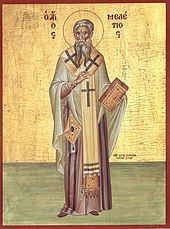Meletius of Antioch
Meletius of Antioch († May 381 in Constantinople ) was Patriarch of Antioch from 360 to 381 and caused the Meletian schism named after him there before he became the leader of the so-called Young Nicene .
Life
Meletius came from Melitene . During the Arian disputes he belonged to the group of Homoeans led by Acacius of Caesarea and thus became Bishop of Sebaste in 358 . As the successor to the popular Eustathius von Sebaste , Meletius was unable to assert himself and soon had to give up the office. In 360 Meletius was consecrated bishop of Antioch on the Orontes , where he succeeded the strict Arian Eudoxius . When he left his followers in office or took them back into office, he was removed from office by Constantius II and replaced by Euzoius .
Despite his exile to Armenia , Meletius managed to pursue his reinstatement, which finally took place in 362 under Julian . A reconciliation with the Group of Nizäner under Paulinus of Antioch failed when Lucifer of Cagliari just have consecrated bishop Paulinus, even before one - in the context of the initiative of Athanasius of Alexandria in Alexandria meeting participants Synod of Alexandria - mediating in the dispute Episcopal Commission in connection the writing of Tomus ad Antiochenus could start their mediation work. Meletius and his followers had to take this as a provocation, which is said to have triggered the so-called Meletian schism (not to be confused with the schism of the same name of Meletius of Lycopolis ). In addition, Athanasius immediately recognized his 'old Nicene' companion Paulinus as bishop and wanted to see the unified Antiochene community under his leadership, not that of Meletius. However, Paulinus from Antioch apparently sent two deacons to Alexandria for the synod. At least the signatures of the deacons Maximus and Calhemerus, which are in an appendix u. a. together with the bishops of the 'Bishops' Commission' confirm the Tomus by signature and are expressly mentioned as the deacons and envoys of Paulinus. The deacons, in turn, could only have been sent to Alexandria by Paulinus if he was already officiating as bishop, so that the reason for the continued existence of the schism in Antioch was probably not due to an untimely, untimely ordination of Paulinus by Lucifer of Calaris, since this probably did not take place at all, despite later information from church historians.
The Meletian schism existed until about the end of the 4th century. This despite the fact that the 'Tomus de Antiochenos' had remedied the theological differences of the schism. After the arrival of Tomus in Antioch, Paulinus testified in an affirmative text including his signature that he accepted the declarations made therein, in particular the language of the three hypostases that he had previously rejected. Meletius also showed that he was in agreement with Tomus in terms of content: when Emperor Julian died in 363 and Jovian succeeded him to the imperial throne, Meletius and the Synod of Antioch of 363 wrote a synodal letter to the new ruler. In it they showed their loyalty to the Confession of Nicaea.
Emperor Valens banished Meletius several more times (from 365 to 367 and 371/372 to 378), under Emperor Gratian the banishment was ended and Meletius reinstated in his office. The recognition of Paulinus (and thus Rome) was denied to him even after a Nicene confession. Nevertheless, Meletius rose to become the leader of the now so-called Young Nicene. In 381 he then led the second ecumenical council, the first council of Constantinople , during which he died. His body was brought back to Antioch in a solemn procession and buried next to the relics of the martyr and bishop Babylas . His successor was Flavian I , who was recognized by Theophilus of Alexandreia in 394 and finally by Pope Anastasius I in 399 . The Meletian schism, however, is only considered to have been overcome with Alexandros I , who became patriarch in 414.
Remarks
- ↑ Gemeinhardt 2006, p. 184.
- ^ Hanns Christof Brennecke, Annette von Stockhausen, Christian Müller, Uta Heil, Angelika Wintjes (eds.): Athanasius works. Third volume, first part. Documents on the history of the Arian dispute. 4th delivery: Up to the Synod of Alexandria 362 . Walter de Gruyter , Berlin / Bosten 2014, p. 604.
- ^ Annette von Stockhausen, Athanasius in Antiochien , in Zeitschrift für Antikes Christentum , Volume 10, Issue 1 (October 2006), pp. 86-102, here p. 91
- ↑ Peter Gemeinhardt: Tomus ad Antiochenos , in: Peter Gemeinhardt (ed.), Athanasius Handbuch . Mohr Siebeck, Tübingen 2011, pp. 228–335, here p. 234.
- ^ Hanns Christof Brennecke, Annette von Stockhausen, Christian Müller, Uta Heil, Angelika Wintjes (eds.): Athanasius works. Third volume, first part. Documents on the history of the Arian dispute. 4th delivery: Up to the Synod of Alexandria 362 . Walter de Gruyter , Berlin / Bosten 2014, p. 607.
- ↑ Gemeinhardt 2006, p. 184 u. 188.
literature
- Eduard Schwartz : On the church history of the fourth century. In: Journal for New Testament Science . Vol. 34, 1935, pp. 129-213, DOI: 10.1515 / zntw.1935.34.1.129 .
- Klaus-Peter Todt : Meletius of Antioch. In: Biographisch-Bibliographisches Kirchenlexikon (BBKL). Volume 5, Bautz, Herzberg 1993, ISBN 3-88309-043-3 , Sp. 1209-1212.
- Thomas R. Karmann: Meletius of Antioch. Studies on the history of the trinity theological dispute in the years 360–364 AD (= Regensburg Studies on Theology. Vol. 68). Lang, Frankfurt am Main 2009, ISBN 978-3-631-56284-0 .
| predecessor | Office | successor |
|---|---|---|
| Eudoxios |
Bishop of Antioch 354 |
Eudoxios |
| personal data | |
|---|---|
| SURNAME | Meletius of Antioch |
| ALTERNATIVE NAMES | Meletios of Antioch |
| BRIEF DESCRIPTION | late antique patriarch of Antioch |
| DATE OF BIRTH | 4th century |
| DATE OF DEATH | 381 |
| Place of death | Constantinople |
